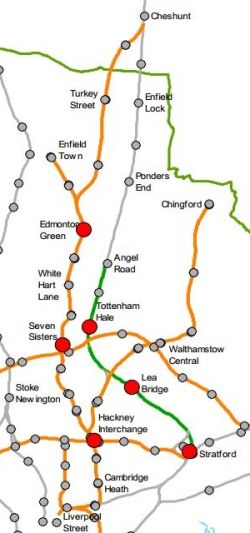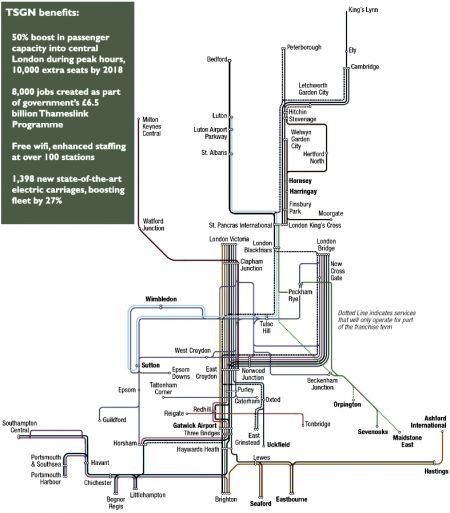In recent months rail services serving both the west and east of Enfield borough have seen changes of operator, promises of improved services but, so far at least, precious few signs of improvements, and in some the service has actually deteriorated. In this article we report on what has occurred so far and what the future holds.
Great Northern
Great Northern is at the top right-hand corner of this diagram, which shows the complete extent of the planned Thameslink network. Click on the diagram to see a bigger version.
A new consortium, Govia, took over the Kings Cross/Moorgate services from First Capital Connect in September 2014, the first step in the expansion of the Thameslink network on both sides of the Thames. The interconnected services will eventually stretch from Kings Lyn in the north east to Southampton in the south west. The increased capacity of the central London section will mean that eventually Palmers Green passengers will be able to change at Alexandra Palace or Finsbury Park onto trains running to the south coast.
Unfortunately, the end of Capital Connect did not bring about the end of its appalling service record. Things became so bad that in January Enfield MPs arranged public meetings with Govia management to discuss the situation.
As suspected, the chief cause of cancellations turned out to be a shortage of drivers, which Govia blamed on the failure of First to retain, recruit and train personnel. My impression is that cancellations are now becoming fewer, but there are still too many. In particular, it is unacceptable that Govia cannot be relied on to run even a half-hourly service at weekends and that some trains still have only three carriages.
The first major change on the Hertford and Welwyn lines will occur in December. Evening and weekend services will run into Moorgate, providing convenient connections at Highbury & Islington. According to a report on Bowes & Bounds Connected, service frequencies will also be increased this December - however, there is no mention of this on the Factsheet issued by Govia.
Some time in 2018 new trains will be introduced, which "will provide a metro-style layout with more capacity, improved reliability, air conditioning and passenger information systems that can be remotely updated to provide real-time travel information". Off-peak trains will increase from three to four an hour - hopefully weekend frequencies will be improved too, though this is not mentioned on the factsheet.
Another improvement will be work to provide step-free access to both platforms at Palmers Green - though this may not happen until 2019. Rather less welcome news is that ticket gates are to be installed at Alexandra Palace, Enfield Chase, Gordon Hill, Hornsey, New Barnet, Palmers Green and Winchmore Hill, which is likely to cause congestion at peak times.
The Seven Sisters lines

People living along the Lea Valley line north of Angel Road (Ponders End, Brimsdown, Enfield Lock) will have to continue to live with poor services. But the news that Transport for London, in the shape of London Overground, would be taking over responsibility for the Seven Sisters lines at the end of May seemed like unalloyed good news to their users. After all, when Silverlink services on the North London lines were transformed into the London Overground a few years ago, there was an immediate improvement in all respects.
Well, I've sure that the expected radical improvements to stations, trains and services will materialise before too long, but the first few weeks of London Overground services to Enfield Town and Cheshunt via Seven Sisters and Chingford via Clapton has seen a major increase in cancellations, mainly because of the poor state of the rolling stock that was transferred from the previous operator, Abellio Greater Anglia, which included eight units that had been left unused and neglected for three years.
As a consequence, the London Overground operator LOROL have had to revise their plans to focus on train reliability to try to operate the service as timetabled. Train refurbishments and service improvements will therefore be postponed - this includes the planned doubling of the service to Bush Hill Park and Enfield Town, which is likely to postponed from December to May 2016.
The map shows London Overground lines in NE London. (Orange denotes existing lines, green is the Stratford - Meridian Water (Angel Road) service, due to start in 2018. Stations marked in red are due to have major improvements, such as the lifts that are now in service at Edmonton Green. Hackney Interchange will combine the current Hackney Downs and Hackney Central stations.)
All passengers will benefit from the lower fares charged by TfL. A bonus for Freedom Pass holders is that they can now travel free beyond the GLA boundary as far as Cheshunt on the London Overground service
For more information about London Overground's original plans for the Sisters lines and their explanation about what has gone wrong, we're indebted to the Bush Hill Park Residents' Association, who have supplied the following report on a meeting with the new operators plus a set of presentation slides entitled Bringing London Overground to West Anglia: TFL's Plan.
Report of LOROL Passenger Group special meeting, Tuesday 14th July 2015, Liverpool Street Station
(Written by the BHPRA railways representative)
I was invited to attend this meeting on behalf of the Bush Hill Park Residents’ Association, and I duly made my way to Liverpool Street Station along with representatives of various rail users’ groups in the West Anglia (Enfield Town, Cheshunt & Chingford) catchment area.
After the introductory explanations about the company and the LOROL concession (as opposed to a franchise) the presentation focussed on the first 6 weeks. The initial bubble of euphoria of a new rail operator was soon burst by the problems that manifested themselves in the form of extensive cancellations and short formations of trains in the peak periods.
As I had suspected, these were mostly caused by the condition of the train fleet. The original fleet was split between London Overground (for the West Anglia services) and TfL Rail (for the Essex suburban services, which will eventually become the eastern arm of Crossrail). The LOROL fleet comprises two classes of train (315 and 317) which are not compatible with each other, so if a 4-car unit fails, it can only be replaced by a unit of the same class when working in multiple, as an 8-car train.
The previous franchisee, Abellio decided at the beginning of the franchise in 2012 to reduce the train fleet by 8 x 317 units, which were then stored at Eastleigh, away from the overhead power lines. When they were brought back into service by LOROL their condition was found to be far worse than expected, not having turned a wheel or had any electric power in over three years, hence the constant failures in service.
LOROL have taken preventative measures in the form of extended maintenance, performed to a higher standard, as well as scheduling to keep the suspect units away from the central peak periods. This means that achieving train fleet reliability will take precedence over everything else, including general refurbishment of the whole fleet, and expansion of the timetable. In practical terms, provisional plans for a shuttle service, which would double the service from Bush Hill Park, will now have to be postponed from a possible December 2015 launch date to May 2016.
I did ask about earlier and later trains at the beginning and end of service, but there are no immediate plans for this. I also mentioned the seeming lack of crowd control at Seven Sisters during periods of disruption, and was told that the station plans for the main interchange points are being re-written – this will include improved passenger information. The on-train passenger information systems will be renewed during fleet refurbishment, and the enclosed passenger interchange between Hackney Downs and Hackney Central on the London Overground Stratford to Richmond and Clapham line is expected to open in the not-too-distant future.
Transport for London has recently signed a contract with Bombardier to build 45 new 4-car trains, of which 31 are destined for the West Anglia services by 2018. These will be built at Derby and will feature walk-through carriages and air conditioning, while the contract includes options for an add-on order, which gives hope of an extended and expanded timetable in the future.
Finally, although this was not discussed at the meeting, TfL has announced that four bidders have been shortlisted to run the London Overground operating concession from November 2016. The current operator, LOROL, is a consortium of MTR of Hong Kong and Arriva, a Deutsche Bundesbahn subsidiary but for the new concession the two companies are mounting separate bids, in competition with LoKeGo (a joint venture between Keolis, a subsidiary of the French state railway company and Go Ahead Holding Ltd) and Metroline Rail Ltd, part of the ComfortDelGro Corporation of Singapore.




